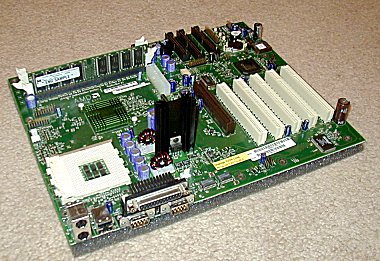De testsysteem van Tech Report werd geleverd met CAS2,5 PC2100 DDR SDRAM. De CAS2,5 is de low-end PC2100 spec (DDR266B). Het is de bedoeling dat er ook snellere DDR266A gekwalificeerde PC2100 DIMMs met een CAS latency van 2 cycles op de markt komen.
In de korte tijd dat Tech Report het AMD testsysteem mocht gebruiken, kwamen er onder Windows 98 geen stabiliteitsproblemen aan het licht. Een korte poging om Linux op het systeem te installeren resulteerde echter in kernel panick toen de vers gebouwde kernel na het rebooten de serial # van de CPU wilde disablen (tja, dat kan alleen op bepaalde PIII's...).
De benchmarks van Tech Report laten een behoorlijk groot voordeel zien voor het 760 systeem. Zelfs de Content Creation Winstone benchmark (fotosop, sound editors, DTP tools e.d.) maakte een stijging van 13,9%. De 1,2GHz Athlon met 760 chipset was in deze test 22,9% sneller dan een 1GHz PIII met Apollo Pro133A chipset. Quake III liet op lage resoluties verschillen zien die vergelijkbaar zijn met de resultaten uit de vorige twee reviews, namelijk rond de 18%. In de hi-poly 3DMark 2000 test leverde het 760 systeen op 800*600 met 1 lichtbron zelfs een 30% hogere score. Blijkbaar is deze benchmark zwaar afhankelijk van de geheugen performance. In de AGP texturing test presteert de 760 gelijk aan de KT133 en Pro133A, wat in ieder geval wil zeggen dat de AGP implementatie niet brak is. Pas bij de 64MB texturing test kan de GeForce2 z'n textures niet meer volledig uit eigen geheugen trekken en kan de 760 voor een klein verschil zorgen:
Barring any catastrophic problems that our testing didn't uncover, the 760 chipset looks like a sure-fire winner. The system we tested, with its 1.2GHz Athlon, PC2100 DDR memory, and 266MHz front-side bus was an absolute screamer—the fastest system we've ever seen, and quite likely more than a handful for Intel's coming 1.5GHz Pentium 4. If AMD and company can deliver motherboards based on the 760 at competitive prices and DDR DIMMs really are relatively cheap, recommending a 760 motherboard with DDR memory to upgraders or new system buyers will be a no-brainer. In certain scenarios, when memory bandwidth is the primary system bottleneck, DDR memory offers substantial performance gains—as high as 25 or 30%—with no notable drawbacks.Those of you who just purchased high-end systems can rest easy knowing that DDR memory isn't the end-all, be-all. It doesn't make your system twice as fast. And in places where DDR can really help, such as 3D performance, another component like the video card is often the primary bottleneck. So don't chuck that expensive new system just yet. [break]
Thanks Thermo voor het insturen van de link!Update 16:05: Ik lees net in deze Slashdot posting dat het Linux probleem een inmiddels bekende en gefixte bug is. In de 2.2.16 kernel en latere versies wordt niet geprobeerd om de CPU s/n te disablen op Duron en Thunderbird processors:[/break] The 760 is NOT at fault. The Linux error he reported is a known bug -- see Red Hat bugzilla ID 19535 (I added the workaround this morning, after realizing that we hadn't put anything up about this on our website). It is basically the kernel trying to disable the P3 serial number -- on the Athlon processor. (oops) It only affects Thunderbird-core Athlons and Durons. It has been fixed in all 2.2.16 and later kernels. I emailed damage to let him know about -- hopefully we'll get to see some benchmarks. After installation, at the LILO boot: prompt use this command:
linux x86_serial_nr=1
That'll get you booted, and you can upgrade/recompile/append to lilo.conf from there. There was supposed to be a Gotcha added for this, but obviously it isn't up yet. I'll track things down today and get it added to the Gotchas page for 6.2


